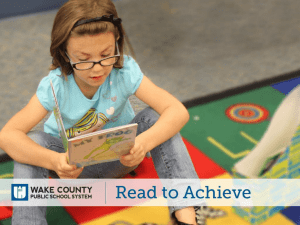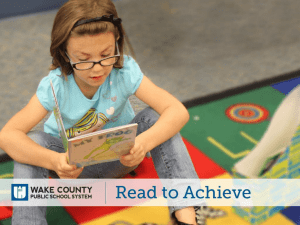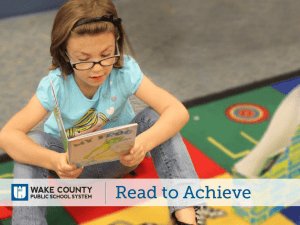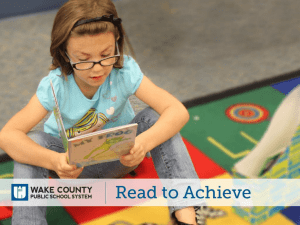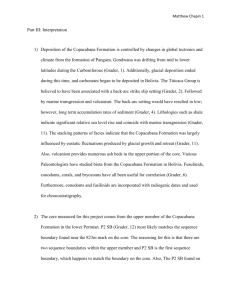HERE - Jeffreys Grove Elementary School
advertisement
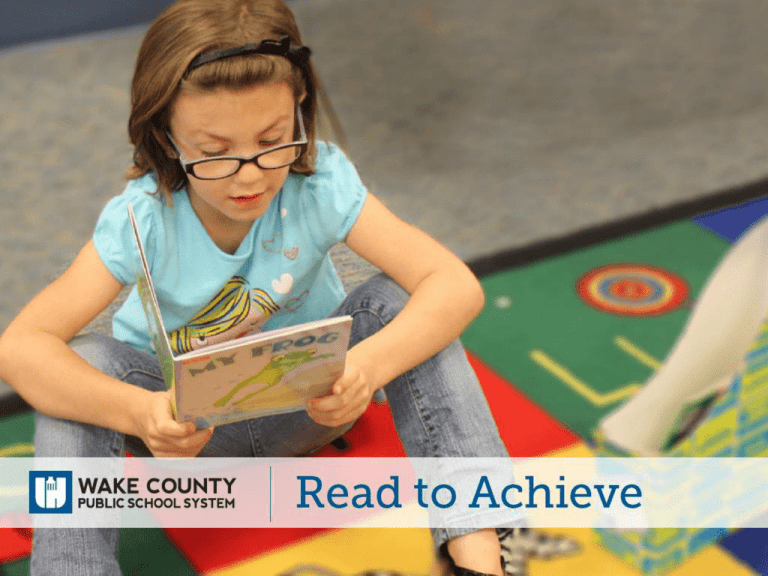
The Read to Achieve program is part of The Excellent Public Schools Act of N.C (NC House Bill 950) which became law in July 2012. The law outlines that if a 3rd grader is not reading at grade level by the end of 3rd grade, they will have to either repeat the third grade or attend reading camp. KEY QUESTIONS • What steps are being taken to get your 3rd grader reading at or above grade level? • How will the State determine if your child is reading at grade level? • What will happen if your child isn’t reading at grade level? • How can you help your child with his or her reading? What steps are being taken to get your 3rd grader reading at grade level? We are providing strong instruction in literacy. What steps are being taken to get your 3rd grader reading at grade level? We are providing extra help to students who need it. What steps are being taken to get your 3rd grader reading at grade level? We are gathering information on your child’s progress. Your child’s teacher will continue to observe and monitor their progress. Your child can take up to 3 passages per week. Passages are aligned to specific standards your child needs to master. These assessments include mCLASS and CASE 21, along with the EOG. What steps are being taken to get your 3rd grader reading at grade level? We are sharing information on your child’s progress. We’ll talk about this specifically during conferences, emails, or reports home. We’ll share standards and scores. You will get formal reports, including the Home Connect letter. What steps are being taken to get your 3rd grader reading at grade level? We are sharing information on your child’s progress. TRADITIONAL CALENDAR STUDENTS How will the State determine that your child is reading at grade level? TRADITIONAL CALENDAR STUDENTS How will the State determine that your child is reading at grade level? Did your child pass the reading section of the EOGs? Yes. Your child moves to the 4th grade. No. Your child’s teacher will look at: Results of portfolio • mCLASS • PEP (if applicable) • Reading passages -or- Read to Achieve Test TRADITIONAL CALENDAR STUDENTS How will the State determine that your child is reading at grade level? Does your child have a successful portfolio or did they pass the Read to Achieve Test? Yes. Your child moves to the 4th grade. No. It will be determined that your child is not reading at grade level. Your child will be enrolled in a free, districtsponsored reading camp. TRADITIONAL CALENDAR STUDENTS If your child is determined to be reading below grade level, you have two choices: Attend Camp Decline Camp • Your child be enrolled in a free, district-sponsored reading camp. • Your child will repeat the 3rd grade. • Your child will receive additional instruction and support in reading. • The law does not allow us to grant exceptions. • Reading camp is scheduled for 6 weeks during the summer break. TRADITIONAL CALENDAR STUDENTS If your child is determined to be reading below grade level, you have two choices: Attend Camp Decline Camp • Your child will be retested at the end of camp and move into the 4th grade. • Your child will repeat the 3rd grade. • Children who are still not reading at grade level will have a ‘retention label’ and receive additional support in 4th grade. • The retention label will be removed if the child demonstrates proficiency by mid-year of 4th grade. • The law does not allow us to grant exceptions. Supporting Literacy at Home Overview Common Core Reading/Writing standards Question Stems for Fiction/Non-fiction text Reading Fluency/Fluency Strategies Comprehension Strategy How to Encourage Writing at Home Resources Common Core Standards National standards that say what K-12 students are expected to learn in the English language arts. Despite the complexities of the standards, there are several basic ways parents can support their child's learning. The recommendations that follow line up with the four broad areas of the Common Core reading standards: Key Ideas and Details Craft and Structure Integration of Knowledge and Ideas Range and Level of Complexity. Key Ideas and Details What it means: Your child will be encouraged to carefully read many books and texts. Within these texts, your child will be working to understand what is happening, summarize key events or points, and recall details important to the story or topic. How parents can help: After you share a story, talk about important story elements such as beginning, middle and end. Encourage your child to retell or summarize the reading. After reading nonfiction, ask questions about the information, "Is the spider an insect? How is a spider different than an insect?" Craft and Structure What it means: The standards within this area (or "strand") focus on specifics within a book, for example, an author's specific word choices or phrases. A second emphasis relates to understanding the underlying structure of common types of texts, including storybooks, poems and more. How parents can help: During and after reading, call attention to interesting words and phrases. This may include repeated phrases, metaphors or idioms ("sick as a dog," "a dime a dozen.") Talk about any new vocabulary and other ways the author used language or words to make the text interesting, informative, funny or sad. Integration of Knowledge and Ideas What it means: Within this strand, students will be working to compare and contrast details from stories, describe key ideas using details in fiction/informational text, and tell how two texts on the same topic differ. How parents can help: Encourage your child to describe how the illustrations within a book support the story. Talk about the similarities and differences between the two books. Then switch to nonfiction and read two books on the same topic. Compare the information in each, again focusing on similarities and differences. "Let's look at each book and think about the words used to describe weather. How are the descriptions alike? How are they different?" Range of Reading and Level of Text Complexity What it means: Teachers will be using a variety of techniques to introduce a range of books and other written material that both support and challenge a child's reading level. This may include nonfiction and fiction, poetry and more. This will be done with the ultimate goal of making sure students understand what they're reading. How parents can help: Parents can help promote their child's skill while developing their reading stamina (ability to "stick with it."). This means helping them avoid frustration or anxiety about tackling a harder book. Support your reader by talking through some of the things that make a text complex, including multiple levels of meaning, inferred information (implied rather than clearly stated) or more sophisticated graphics. Question Stems for Fiction Texts Literal Key Concepts: Characters, setting, problem, plot detail What happened in this story? Who are the characters? Where does it happen? Inference Key Concepts: Connects details of story, grasps implicit meaning. Is it possible that….? What might have happened before/after…? Critical Key Concepts: Evaluates story information and meaning. Do you have opinions about the story? What do you like/not like about the story? Creative Key Concepts: Imagination sparked by story Has anything like this happened to you? Tell a story that comes to mind after reading this. Question Stems for Non-fiction Texts Literal Key Concepts: Characters, setting, problem, plot detail What is the book about? What is the most important Critical Key Concepts: Evaluates story information and meaning. Did you like the book? What questions do you still have about…? info? What did you lear Inference Key Concepts: Connects details of story, grasps implicit meaning. What details help you to know that…? Creative Key Concepts: Imagination sparked by story What else would you like to learn about this? Can you relate this book to your life? Why Focus on Fluency? Reading fluency is the ability to read phrases and sentences smoothly and quickly, while understanding them as expressions of complete ideas. If there are weaknesses in fluency, students will not process groups of words as meaningful phrases. They may also make decoding errors in reading which slow them down and prevent them from grasping the meaning of the sentence. As a result, they do not understand and remember meanings of passages. How can we foster reading fluency? Paired or "Buddy" Reading Reread Favorite Books Record It “Click or Clunk” Comprehension Strategy Students periodically check their understanding of sentences, paragraphs, and pages of text as they read. When students encounter problems with vocabulary or comprehension, they use a checklist to apply simple strategies to solve those reading difficulties. Instruct your child that, during any reading assignment, when they come to: The end of each sentence, they should ask the question, "Did I understand this sentence?" If students understand the sentence, they say "Click!" and continue reading. If they do not understand, they say "Clunk!" and refer to the strategy sheet My Reading Check Sheet to correct the problem. At the end of each paragraph, they should ask the question, "What did the paragraph say?" If they do not know the main idea(s) of the paragraph, students refer to the strategy sheet My Reading Check Sheet to correct the problem. The end of each page, they should ask the question, "What do I remember?" If they do not remember sufficient information, students refer to the strategy sheet My Reading Check Sheet to correct the problem How can I encourage my child to write? Read your child’s writing or have him or her read the writing to you and comment on the positive aspects, for example, “I really like the way you’ve described this.” Praise your child for having a go at writing words that are new and explain how to spell words which are causing difficulty. Talk to your child about why an author or film maker might create a book, play or film in a particular way. What points of view are presented? What is the author’s purpose? Read and talk about the writing that your child brings home from school. Focus on the content of their writing and avoid spending too much time on conventions. In order to develop spelling and vocabulary, play word games such as I Spy, Scrabble, Boggle, Scattergories and crosswords Resources to use with your child Scoot Pad “Just Right” Books (Remember the “Five-Finger” Rule) School Library/Public Library Books Newspaper/Magazines … How else can I help my child with his or her reading? Read together for at least 20 minutes each day! • Parent/Teacher Communication • Home Connect Activities • Visit the library • Stay involved
